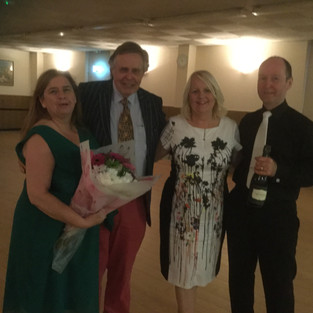Grow your Dance Family
- Lynn Armsby

- Apr 9, 2018
- 3 min read
Updated: Apr 12, 2018
Social dance teaching has changed so much over the years. Most dance schools had their own premises and would provide opportunities for students to attend dances and social events in the school to become part of the “family” of the dance school. This is the way some schools in the United Kingdom still conduct their business. It is also the way that dancing is taught in many parts of the global dance community. In the USA, the school system (Arthur Murray and Fred Astaire franchises) fully utilises this, by selling lessons and attendance at social functions in one package. However, increasingly more and more of us are working out of community halls and perhaps run a practice night or incorporate a period of practice into our teaching evenings.
In my own school, my staff have been particularly proactive in attending local dances and engaging our students to join them. This means that people who may be a little shy about dancing outside of the school environment when they are still learners feel more comfortable. They feel supported by the teachers and are welcomed at dances as a group. For our local area, covering some of Cambridgeshire, Buckinghamshire and Northamptonshire, this has been hugely successful with reciprocal support at our own dances. Are we particularly lucky in that none of our dancers have been “poached” by other schools on these visits? I don’t think so. As professionals we respect each other and after a few years of doing this, Dance Action has not lost any of its dance students to schools we attend as a group. At a recent networking event I held in association with my colleague and friend Jill Kemp, several professionals were invited to share information. Feedback from the event was a joy to read and all professionals benefitted from the sharing. Professional Julie Holland offered some insights in to her 'dance family'. Her ethos resonated with many of us.
What does community look like in the middle of a dance school? - Julie Holland
· An atmosphere where everyone is welcome (whether it’s widowers stepping out for the first time, or individual dancers without a partner to adults with special needs all are welcome).
· Family develops – as community builds there is a sense of family that begins to knit people together and relationships build
· Care – as people become a community it’s not unusual to see people in classes helping each other out with life’s problems
· Social – social events help to foster this, ie trip to Midlands Championships last week, Social Dances, Christmas Parties etc
· A culture develops where there are no “cliques” – this means people are more likely to recommend a friend to come
· Retention rates – these increase as people want to stay around something that they feel they belong to
· Volunteering develops as people want to sow into this community and give something back
· Helping one another with steps or with partners is commonplace amongst the dancers
· A generous spirit features – being focused on the people rather than the profit ensures that people sense they are valued rather than a business transaction
· Transparency means that everyone is welcome to attend other dances, go to other schools for lessons and I am always happy to recommend other teachers for specialisms or social events. People pick up on this and this adds to the overall positive atmosphere.
· Values are developed intrinsically – people begin to display the same values being modelled from the front without consciously realising.
And as a result you have one successful happy Dance School with great retention rates and satisfied clients!












Comments